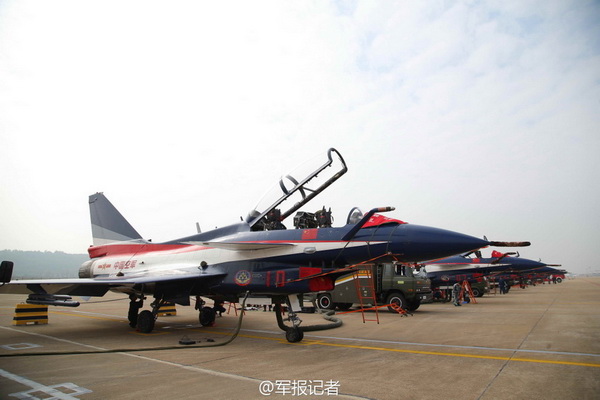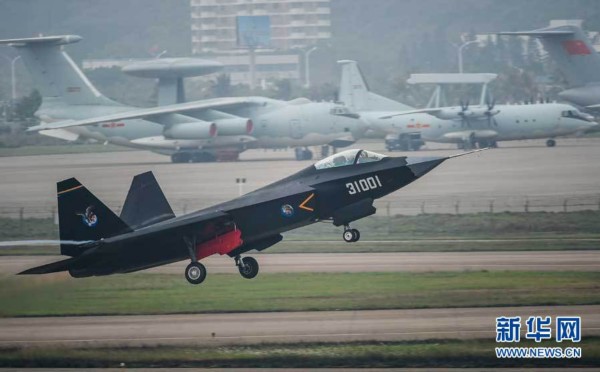


File Photo
Two Chinese J-10 fighter jets were accused by the U.S. Navy of conducting unsafe and unprofessional maneuvers while intercepting a U.S. surveillance aircraft near the South China Sea on May 24. This incident is the second close brush involving American and Chinese aircraft in the disputed region this month.
U.S. Navy Commander Gary Ross confirmed the incident to CNN on May 26, noting that the U.S. continues to review the facts of the incident and will convey its concerns through “appropriate channels” to the Chinese government.
Citing a U.S. official, the CNN reported that one Chinese fighter flew about 200 yards in front a U.S. P-3 spy plane and began conducting multiple turns.
The Chinese government has yet responded to the latest event.
This latest encounter comes on the heels of a U.S. military plane conducting reconnaissance activities in airspace over Chinese waters on May 17, according to the Chinese defense ministry.
The U.S. Air Force said that two Chinese SU-30 aircraft intercepted a U.S. Air Force radiation detection plane over the East China Sea on May 17, according to CNN. The U.S. crew aboard the aircraft characterized the move as "unprofessional.”
However, the Chinese Ministry of National Defense responded that the U.S. military plane was conducting reconnaissance activities over the Yellow Sea, and the Chinese pilots’ behavior was both safe and professional.
"What the U.S. military said is not in accordance with the facts. On May 17, a U.S. military plane conducted reconnaissance activities in air space over Chinese waters of the Yellow Sea. Chinese military aircraft identified and verified the U.S. military plane in accordance with the law. Our actions were professional and safe," Colonel Ren Guoqiang, spokesperson for the Ministry of National Defense, said at a regular press conference on May 25.
“The frequent close-in reconnaissance by U.S. military ships and planes is the root cause of maritime and air security problems between China and the U.S.,” Ren added. “We hope the U.S. side can stop relevant close-in reconnaissance activities against China and prevent such events from happening again.”

File Photo
Tensions between Chinese and American military planes have continued since Donald Trump became the U.S. president. Though Trump has yet to announce a clear policy on the Asia Pacific, the U.S. Department of Defense and the White House have reiterated a tough stance on maintaining a military presence in the South China Sea.
Many Chinese military experts hold a dim view on the possibility of the U.S. changing its South China Sea policy. Li Jie, a Beijing-based naval expert, told the Global Times after a U.S. nuclear-powered carrier entered the South China Sea in February that compared to his predecessor, Trump may increase tensions in the waters, and China should prepare both diplomatically and militarily.
Though the U.S. has been using “freedom of navigation” as an excuse to carry out reconnaissance activities against China, Beijing has expressed several times on different occasions that the South China Sea dispute should be dealt with only by countries that are directly involved. China believes outside interference will only increase tensions.
 Fire brigade in Shanghai holds group wedding
Fire brigade in Shanghai holds group wedding Tourists enjoy ice sculptures in Datan Town, north China
Tourists enjoy ice sculptures in Datan Town, north China Sunset scenery of Dayan Pagoda in Xi'an
Sunset scenery of Dayan Pagoda in Xi'an Tourists have fun at scenic spot in Nanlong Town, NW China
Tourists have fun at scenic spot in Nanlong Town, NW China Harbin attracts tourists by making best use of ice in winter
Harbin attracts tourists by making best use of ice in winter In pics: FIS Alpine Ski Women's World Cup Slalom
In pics: FIS Alpine Ski Women's World Cup Slalom Black-necked cranes rest at reservoir in Lhunzhub County, Lhasa
Black-necked cranes rest at reservoir in Lhunzhub County, Lhasa China's FAST telescope will be available to foreign scientists in April
China's FAST telescope will be available to foreign scientists in April "She power" plays indispensable role in poverty alleviation
"She power" plays indispensable role in poverty alleviation Top 10 world news events of People's Daily in 2020
Top 10 world news events of People's Daily in 2020 Top 10 China news events of People's Daily in 2020
Top 10 China news events of People's Daily in 2020 Top 10 media buzzwords of 2020
Top 10 media buzzwords of 2020 Year-ender:10 major tourism stories of 2020
Year-ender:10 major tourism stories of 2020 No interference in Venezuelan issues
No interference in Venezuelan issues
 Biz prepares for trade spat
Biz prepares for trade spat
 Broadcasting Continent
Broadcasting Continent Australia wins Chinese CEOs as US loses
Australia wins Chinese CEOs as US loses